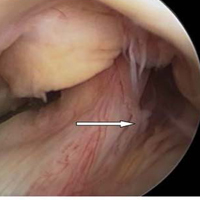Menisco-ligamentous injuries of knee joint: Can ultrasonography serve as an effective screening modality?

Accepted: 15 July 2021
HTML: 70
All claims expressed in this article are solely those of the authors and do not necessarily represent those of their affiliated organizations, or those of the publisher, the editors and the reviewers. Any product that may be evaluated in this article or claim that may be made by its manufacturer is not guaranteed or endorsed by the publisher.
The aim is to calculate sensitivity, specificity and diagnostic accuracy of Ultrasonography (USG) as a screening modality in evaluation of Menisco- Ligamentous injuries of knee joint with Magnetic Resonance Imaging (MRI)as gold standard for comparison.Patients with clinically suspected Menisco-Ligamentous injurieswere evaluated by USG initially followed by MRI on the same day. A total of 60 patients (50 males, 10 females) underwent USG and MRI. USG was done using high frequency probe (9-14 Hz) and all the injuries noted. USG of the normal knee was done for comparison. MRI with trauma protocol sequences was done on the same day. The accuracy of USG and MRI in diagnosis of menisco-ligamentous injuries was compared. Majority of the patients (50%) belonged to age group of 21-40 years. Most common injuries seen were medial meniscal tear followed by medial collateral ligament injury. The strength of agreement between USG and MRI was good with Diagnostic accuracy of USG ranging from 83.3% to 95% for different meniscal/ligamentous injuries.USG is an effective imaging modality with high accuracy in diagnosing menisco-ligamentous injuries. USG can act as an effective screening modality in closed knee trauma for evaluation of menisco- ligamentous injuries especially in resource constrained regions owing to its easy availability, portability and lower cost. MRI can be reserved for patients with suspicious USG and clinical findings.
Kapur S, Wissman RD, Robertson M, et al. Acute knee dislocation: revive of an elusive entity. Curr Probl Diagn Radiol 2009;38:237-50.
Abulhasan JF, Grey MJ. Anatomy and physiology of knee stability. J Funct Morphol Kinesiol 2017;2:34.
Yaqoob J, Alam MS, Khalid N. Diagnostic accuracy of magnetic resonance imaging in assessment of meniscal and ACL tear: Correlation with arthroscopy. Pak J Med Sci 2015;31:263-8.
Navali AM, Bazavar M, Mohseni MA, et al. Arthroscopicevaluation of the accuracy of clinicalexamination versus MRI in diagnosingmeniscustears and cruciate ligamentruptures. Arch Iran Med 2013;16:229-32.
Ward BD, Lubowitz JH. Basic knee arthroscopy part 3: Diagnostic arthroscopy. Arthrosc Tech 2013;2:503-5.
Friberger Pajalic K, Turkiewicz A, Englund M. Update on the risks of complications after knee arthroscopy. BMC Musculoskelet Disord 2018;19:179.
Salzler MJ, Lin A, Miller CD, et al. Complications after arthroscopic knee surgery. Am J Sports Med 2014;42:292-6.
Jacobson JA. Knee ultrasound. In: Jacobson JA, ed. Fundamentals of musculoskeletal ultrasound, 2nd edition. Philadelphia, PA: Elsevier Saunders; 2013: 212-56.
Patil P, Dasgupta B. Role of diagnostic ultrasound in the assessment of musculoskeletal diseases. Ther Adv Musculoskelet Dis 2012;4:341–55.
Bianchi S, Martinoli C, Bianchi S. Knee. In: Baert AL, ed. Ultrasound of the musculoskeletal system. Berlin Heidelberg: Springer-Verlag; 2007: 637–744.
Nasir AI.The role of magnetic resonance imaging in the knee joint injuries. Int Res J Medical Sci2013;1:1-7.
Friedl W, Glaser F. Dynamicsonographyin the diagnosis of ligament and meniscal injuries of knee.Arch Orthop Trauma Surg 1991;110:132-8.
Ptasznik R,Feller J,Bartlett J, et al.The value of sonography in the diagnosis of traumatic rupture of the anterior cruciate ligament of the knee. Am J Roentgenol 1995;164:1461-3.
Monem SAE, Enaba MM. Comparative study between High ResolutionUltrasound (HRUS) and MRI in the diagnosis of meniscal and cruciate ligament injury of the knee. Med J Cairo Univ2012; 233-42.
Wang C, Shih T, Wang H, Chiu Y, Wang T. The accuracy of ultrasonographic examination of injured posterior cruciate ligament. J Med Ultrasound 2009;17:187-92.
Bhanupriya S, Khushal N, Suhas SG, et al. Evaluationof knee joint by USG And MRI. IOSR-JDMS 2016;15:122-31.
Attya MSA. Evaluation of role of non ionized radiology tools in knee soft tissue injuries. Al-Azhar Assiut Med J 2015;13:52-9.
Amandeep S, Indermeet M, Thukral CL, et al. Diagnostic accuracy of USG in Evaluation of knee injuries with MRI correlation.IJARS 2018;7:RO50-5.


 https://doi.org/10.4081/hls.2021.9731
https://doi.org/10.4081/hls.2021.9731



